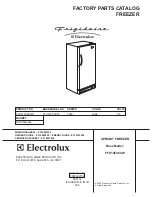
Align the custom panel in the Z direction:
u
Loosen the adjusting screw on the crosspiece and the
screw on the mounting bracket.
u
Move the door.
Fig. 64
u
Check the gap between the custom door panel and the
unit body.
u
Check all screws and retighten them if necessary.
Fig. 65
u
Clip the top cover on.
14.5 Checking the installation
u
Check the following points to ensure the appliance is
correctly installed. Otherwise, ice and condensation may
form, and malfunctions may occur.
w
The door must close properly.
w
The custom door panel must not touch the body of the
unit.
w
The seal on the upper corner on the handle side must be
fitted securely.
15 Cabinet fronts
15.1 Dimensions
Depending on your model, you will need one or two cabinet
doors. The size of the cabinet door(s) depends on the overall
recess size and cabinet unit thickness.
Note
Observe the appliance and recess dimensions and follow
the installation diagrams . See the relevant catalogue for
the installation diagrams.
General requirements:
-
Please refer to our catalogues for appliance-specific
recommendations on size and weight for fixed door
installations.
-
The cabinet unit thickness should be at least 16 mm and
no bigger than 19 mm.
-
When mounting a 2-door cabinet door, observe the
recommended clearances.
Fig. 66 Clearances for a 2-door
cabinet door
Recess
height
Appliance
height (A)
(mm)
Distance (B)
(mm)
Clearance (C)
fixed door
(mm)
178-2
drawers
1770
15
549+15
178-3
drawers
1770
15
695+15
Other cabinet door above, below or next to it:
-
Vertical gap between cabinet doors must be 4 mm.
-
Horizontal gap between cabinet doors must be 4 mm.
Check the collision factors here (see 15.3 Setting the
clearance to avoid collision) .
Weight and hinges:
-
Heavy cabinet fronts increase the stress on the hinge.
The hinge may be damaged. As such, refer to the cata‐
logue for the maximum weight specification for your
appliance.
-
If the cabinet front exceeds the maximum permitted
weight, an appliance with door-tracking device can help
by loading the weight over several concealed hinges on
the cabinet.
-
If you use long unit fronts that protrude far above the
appliances, we recommend an additional door hinge (e.g.
Kamat), which must have the same pivot point as the
fixed door hinge used with your appliance. By using
another hinge (Kamat), the weight is shared over several
points. The use of a milled compensating fastening is
recommended for high unit fronts to counteract warping
(convex/concave).
Cabinet fronts
62
* Depending on model and options



































